BMW On-Board Computer User Manual
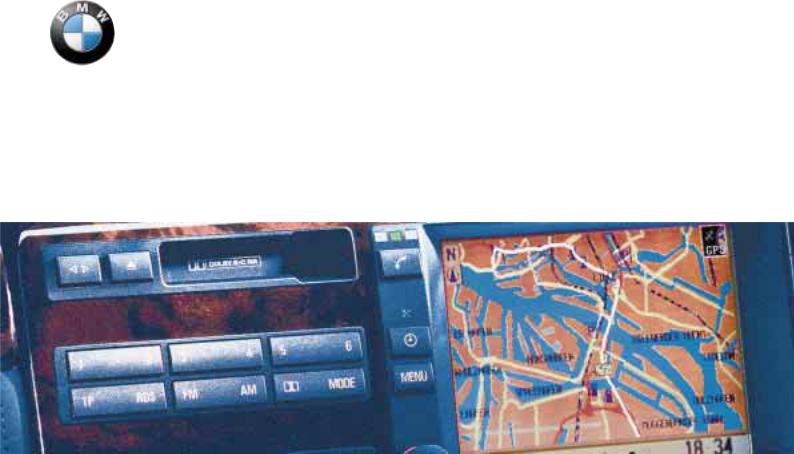
Operating Instructions for
On-Board Computer with Navigation and TV. Advanced technology.
The on-board monitor offers you a great many functions which will make your journeys even safer and more of a pleasure.
The GPS navigation system means that you do not have to consult printed maps or search for road signs; it brings you accurately to any destination shown on the map CD.
The radio, cassette and CD ensure the best possible signal reception and choice of entertainment for all listeners' tastes, and take the monotony out of even the longest journey. The DSP sound system transports you to the concert hall, jazz club or cathedral – with the ideal audio environment for every station.
The on-board computer calculates data relevant to the journey – average fuel consumption, range and estimated time of arrival. It also provides additional safety when driving — for example by supplying a warning signal if your car's speed exceeds the limit you yourself have selected.
The car's auxiliary fuel-burning heater and independent ventilation control system with provision for advance programming ensure that a pleasant interior climate always awaits you when you enter the car.
An individual code number can be input as an additional safeguard against theft of your vehicle.
The TV with teletext ensures a supply of topical information and provides in-car entertainment while you are waiting.
The GSM car phone means that you can always be contacted and make outgoing telephone calls.
We wish you an enjoyable motoring experience.
BMW AG

2
Notes on these Operating Instructions
So that you can enjoy using the onboard monitor as soon as possible, the first section of this handbook describes all the navigation system, radio, onboard computer and TV functions you are likely to need most frequently.
These examples explain how to use the simple menu guidance procedure to allow you to gain rapid access to all the facilities which the equipment offers.
The on-board monitor and the instructions can be regarded as a single unit: Whenever the equipment guides you through its various functions, these details are not repeated in the handbook. The same applies to self-explanatory screen displays.
Since there are other methods of operating the telephone as well as by way of the on-board monitor, the complete telephone operating instructions are issued in a separate handbook.
The quickest way to locate specific topics is by reference to the index at the end of the handbook – all the technical information you need and details of how to look after the equipment are given in "Technical features in detail". And so that minor malfunctions do not interfere with the versatility of your on-board monitor, the section headed "What to do if ..." contains an overview of queries which may arise.
Should you sell your BMW at a later date, please remember to pass these Operating Instructions on to the next owner – it is a legally required element in the vehicle's specification.
Symbols used
identifies details which are essential for you to read – for your own safety and that of others, and to protect
the on-board monitor or the complete car from possible damage.c
is used to identify details of special features.c
c marks the end of a specific item of information.
* identifies optional extras or specific national-market items of equipment, and also accessories.
If you have any queries, BMW Service will be glad to advise you.
© 1999 BMW AG
Munich, Germany
Not to be reproduced wholly or in part without written permission from BMW AG, Munich. Order No. 01 41 0 002 576
English V/99 Printed in Germany
Printed on environmentally friendly paper (bleached without chlorine, suitable for recycling)
Equipment
Your on-board monitor has the following basic equipment specification:
dGPS navigation
dRadio with cassette player
dCode for engine immobiliser
dOn-board computer
dTelevision (TV)
Further equipment which can be specified:
dCar telephone (separate handbook)
dCD changer
dDigital Sound Processing (DSP) sound system
dAuxiliary fuel-burning heater/ independent ventilation control.
If your car is equipped with a multifunction steering wheel, the controls on the wheel can also be used to operate the radio. In a BMW 7 Series model, there is a connection for a rear-seat TV with video recorder, so that passengers occupying the rear seats can watch TV while the car is being driven.
3n
Status at time of printing
The advanced technological features and high quality standard of BMW equipment are maintained by an ongoing development process. This may lead to discrepancies between the information in this handbook and the actual equipment installed in or on the car. Nor can errors and omissions be entirely ruled out. You are therefore asked to appreciate that no legal claims can be entertained on the basis of the data, illustrations or descriptions in this handbook.
4

Initial overview
GPS navigation
Radio, cassette, CD, DSP Sound System
On-board computer, code, auxiliary heater/ventilation
Television (TV)
Technical items in detail
Index
5n
Computer Radio Navigation Overview
Technical TV
Index
Contents
overview |
The on-board monitor at a |
|||
for the navigation system: |
||||
|
glance 10 |
|
|
|
Initial |
Example |
|
|
|
Input of a destination address |
||||
|
||||
|
and guidance to it |
14 |
||
|
Basic radio functions: |
|||
|
Selecting a station |
18 |
||
|
Tone control |
19 |
|
|
|
Traffic reports |
20 |
|
|
Example
for the on-board computer:
Selecting road speed at which limit signal is heard 21
Example for the TV:
Automatically storing TV stations and viewing enjoyment 23
Example for teletext:
Latest information always available via teletext 25
Changing the settings 27
Operation via the multifunctional steering wheel 29
GPS navigation
Safety 32
Getting started 32 Destination input in detail 32 Minor roads 38
Terminating destination guidance 39
Displaying route 40 Selecting a new route 41 Traffic information 42 Vehicle position 46 Compiling a list of
destinations 47 Varying volume 48 Changing the map CD 48
Radio, cassette, CD, DSP Sound System
Station selection 50 Storing stations 52 Regional stations 52 Traffic report stations in
background 53 Cassette 54
CD play 55
DSP sound system 57 CD changer 58
CD changer AI 59 PI CD changer 60
On-board computer, code, auxiliary heater/ventilation
Getting started 62 Speed limit 62 Range 63
Distance and time of arrival 63 Outside temperature 64
Fuel consumption 64 Stopwatch 65 Speed 65
Remote control 65
Code: prevents unauthorized persons from starting the engine 66
Auxiliary fuel-burning heater/ independent ventilation control 68
Television (TV)
Selecting a station 70 Storing a station 71 Adjusting the TV screen 72 Selecting TV format 72 Teletext 73
Connection for TV and video recorder for rear passengers in the BMW 7
Series 74
Technical items in detail
7n
Diversity function 76 Dolby 76
DSP 76 Television (TV) 77
Radio-controlled clock in the BMW 7 Series 77
GPS 78 CD map 78 RDS 79
Care of technical equipment 79 TMC traffic information 80
TP function 80 Wordmatch principle 81
Contents
Index
What to do if ... 84 From A to Z 87

The on-board monitor at a glance 10
Input of a destination address and guidance to it 14
Selecting a station 18 Tone control 19 Traffic reports 20
Selecting road speed at which limit signal is heard 21
Automatically storing TV stations and viewing enjoyment 23 Latest information always availa-
ble via teletext 25 Changing the settings 27 Operation via the
multifunctional steering wheel 29
Initial overview
GPS navigation
Radio, cassette, CD, DSP Sound System
On-board computer, code, auxiliary heater/ventilation
Television (TV)
Technical items in detail
Index
9n
Computer Radio Navigation Overview
Technical TV
Index
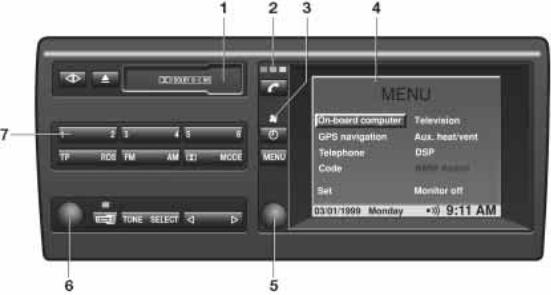
10 The on-board monitor at a glance
bm4de027

The on-board monitor at a glance
Displays and controls
1Tape slot
2Telltales for the car phone Yellow:
The telephone is logging onto another network
Green:
A connection has been established Red:
Comes on if telephone operation is not possible;
flashes if the telephone is not registered in a network.
It is always possible to make emergency calls, irrespective of these displays.
There are separate operating instructions for your telephone.
3Telltale for auxiliary fuel-burning heater or independent ventilation control
On: auxiliary fuel-burning heater or independent ventilation control is programmed
Flashing: auxiliary fuel-burning heater or
independent ventilation control is running.
4Monitor for displaying all systems available on the on-board monitor
5All on-board monitor systems are operated using this knob.
Turn: this selects a system or a displayed function or setting.
Press: this confirms the selection and starts the system or function, or confirms an input.
6Audio volume is adjusted at this knob.
Press: switches the radio on and off
Turn: to vary volume of d radio, cassette, CD
d hands-free use of the telephone d navigation announcements.
7Station buttons for radio operation
11n
Computer Radio Navigation Overview
Index Technical TV

12 The on-board monitor at a glance
Tuning the radio
Each time this button is pressed, the radio cycles through the AM preset ranges MW (medium wave), SW (short wave) and LW (long wave).
Each time this button is pressed, the radio changes between the FM preset ranges FM and FMD (diversity function = 2 receivers).
There are 6 station preset buttons for FM (VHF) and 6 each for MW, SW and LW.
These buttons are also used for selecting a particular CD.
Switching TP function on/off:
Traffic reports are also received during cassette, CD and TV operation, or if you are tuned to a station which does not broadcast traffic reports.
You can tune to a special traffic report station.
Call up the RDS function and choose between:
dRDS On/Off
On FM (VHF), you can switch on the RDS function to have the station's name displayed
dRegion On/Off
On FM (VHF), certain stations may broadcast regional stations either all day or at certain times of day only
dFreq On/Off
The frequency can be displayed in addition to the name of the station.
Search in the radio, cassette and CD modes.
Changing mode
Each time the button is pressed, the mode switches between radio, cassette and CD.
The display on the monitor switches between the radio functions (radio, CD, cassette) and the on-board monitor system that is currently active.
Searching for a station or title
Call up the search function and choose between:
dm Manual station selection
dSCAN search
dII Search sensitive (weak signal)
dI Search non-sensitive (strong signal).
The on-board monitor's general menu appears – you can now select from the systems displayed.
Also returns you from each display or setting to the general menu. Therefore also important if you wish to interrupt an adjustment.

The on-board monitor at a glance
Cassette |
Tone control |
Switching  B or C on/off: see page 76.
B or C on/off: see page 76.
To change tape direction.
Cassette eject
To call up tone control and select between:
dBass: amplifies or attenuates low notes
dTreble: amplifies or attenuates high notes
dFader: louder at front or rear
dBalance: louder on right or left.
13n
Auxiliary fuel-burning heater/
independent ventilation control/ |
Overview |
|
time |
|
|
|
|
|
d Switches independent ventilation |
Navigation |
|
|
||
control off |
|
|
Shows the time in ignition key posi- |
|
|
tion 0. |
|
|
Radio-controlled clock in the |
|
|
|
||
BMW 7 Series |
Radio |
|
The time is automatically corrected. If |
||
you are currently in a time zone other |
|
|
|
||
Computer |
||
than Central European Time (e.g. Portu- |
||
|
||
gal), the hour display can be changed |
|
|
using the input buttons. |
|
|
The date is automatically adjusted. |
|
|
|
||
If your car is momentarily unable to pick |
|
|
up the radio signal, e.g. when in an |
|
|
underground garage with concrete |
TV |
|
walls or driving through a mountain |
||
gorge, or due to local interference from |
|
|
Technical |
||
other electrical equipment currently in |
||
|
||
use, such as a laptop or a retrofitted |
|
|
mobile phone, the time and date can be |
|
|
changed, see page 27. |
|
|
|
|
|
|
Index |
|
|
|

14 Input of a destination address and guidance to it
An example of how to use the GPS navigation system to find the following destination in Germany:
Munich, Leopoldstrasse 194
Only enter data when the car is standing still, and always obey the
traffic regulations and road signs in the event of any contradiction between the traffic situation and the instructions given by the navigation system. Failure to do so may result in an infringement of traffic laws and put the car's occupants and other road users at risk.c
1 Select GPS navigation
The general menu appears.
1Turn until "GPS navigation" is highlighted.
2Press to start the system.
2 Enter destination country
If the name of a country appears on the monitor in white letters, data for more than one country is stored on the map CD.
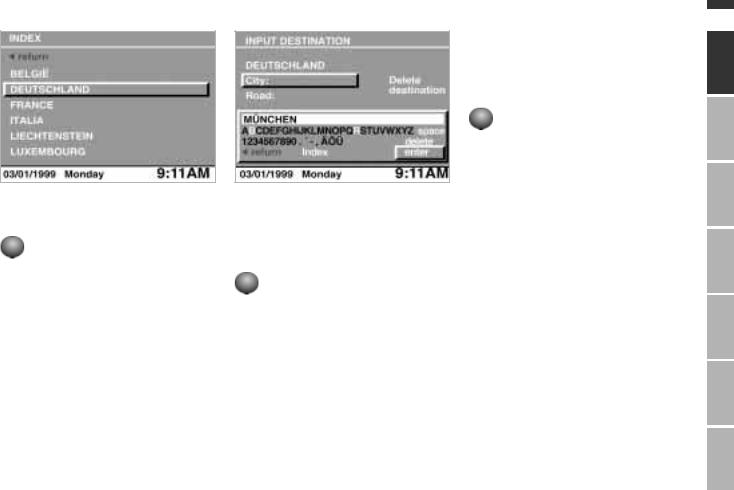
Input of a destination address and guidance to it
To select Germany as the destination country:
1Turn until the currently displayed name is highlighted.
2Press to call up a list of all available countries.
3Turn until "Deutschland" is highlighted.
4Press to accept your selection as the destination input.
3 Input the destination
"City:" or the name of the last destination city entered is highlighted.
To select Munich as the destination:
1Press to activate the input.
2Turn until "M" is highlighted
3Press to confirm the selection.
15n
Use the same procedure to select all the remaining letters of the destination "Munich", until the name of the city is recognised beyond all doubt and displayed in full.
4Turn until "enter" is highlighted.
5Press to store the destination city.
Computer Radio Navigation Overview
Index Technical TV
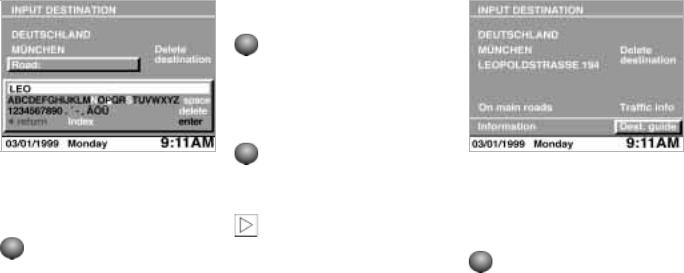
16 Input of a destination address and guidance to it
4Input the road and house number
"Road" or the name of the last destination road entered is highlighted.
1Press to start the input
2Turn until "L" is highlighted.
3Press to confirm the selection.
In the same way, select all the remaining letters of "Leopoldstraße" until the road is identified beyond doubt and displayed in full.
After entering the road, you can select a house number, e.g. "194".
4Turn until "1" is highlighted
5Press to confirm the selection.
In the same way, select all the remaining numerals making up the building or house number.
6Turn until "enter" is highlighted.
7Press to complete the entry.
If the building number is not stored on the CD, the nearest
building number will be entered. There will be no option for entering numbers if no house numbers are stored on the map CD for the street. Destination guidance can be started straight away.c
5 Start destination guidance
When you have entered the complete destination address, the city, road and house number are displayed on the monitor; "Dest. guide" is highlighted.
Press to start destination guidance.
While the navigation computer is calculating a route to your destination, the distance and direction to the destination as the crow flies is displayed at the top right.
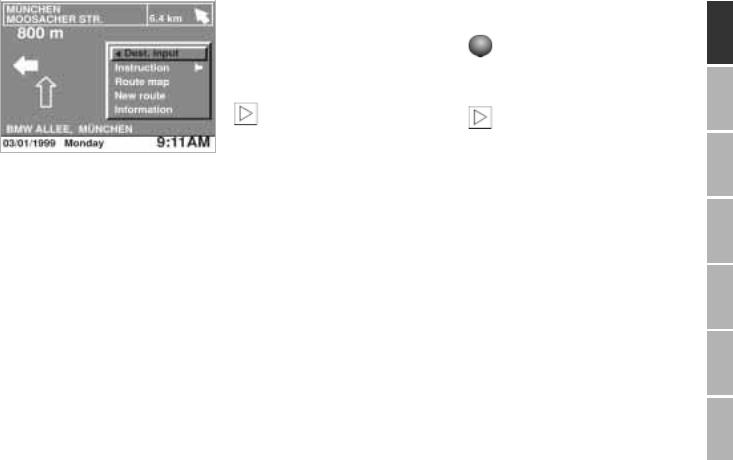
Input of a destination address and guidance to it |
17n |
|
|
Once the route has been calculated, the name of the road which the arrow instructs you to take and the distance to the next junction are shown at the top left.
A change of direction is indicated by the spoken instructions.
The distance to the next turning is shown at the top right. An arrow indicates the direction of the chosen destination as the crow flies.
Your current position is shown at the bottom left.
In areas which are not yet fully covered by the map CD, a direc-
tional arrow indicates the route to be taken. This should help you decide which way to go when you reach a fork in the road or a junction.c
To repeat the last direction announcement:
1Turn until "Instruction" is highlighted.
2Press the button.
You will likewise be directed to your destination if you select an-
other function of the on-board monitor with the menu button, e.g. radio or onboard computer.
A spoken instruction will be given and a visual display will appear on the screen well before the next turning, informing you of any change of direction required.c
Computer Radio Navigation Overview
Index Technical TV
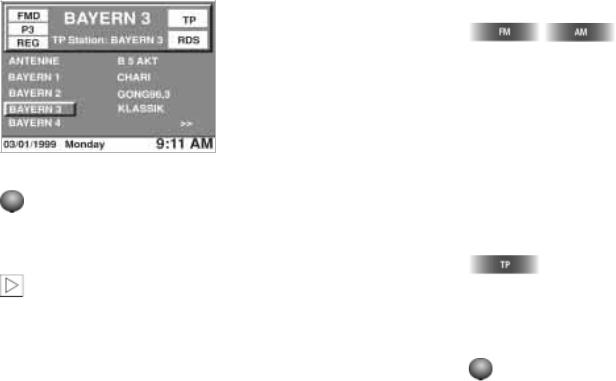
18 Selecting a station
1 Switching on the radio
Press the left-hand button:
A display appears on the screen informing you about the current settings.
Switch off the function "Audio+OBC" if on-board monitor
functions appear on the screen when the system is switched on, see
page 27.c
2 Reading off information
Bayern 3
Name of radio station.
FMD
Waveband; for other wavebands, see next column.
P3
Station button, number of preset.
TP
Traffic Programme is switched on, see page 80.
T
May appear instead of "TP", and means:
The Traffic Programme is not switched on, but the radio is tuned to a station which broadcasts traffic reports.
RDS
Radio Data System is switched on: Station names are displayed and the strongest frequency on which the station can be picked up is searched for automatically, see page 79.
REG
Regional stations can be received, see page 52.
>>
Further stations can be displayed.
3 Selecting the waveband
Changes over as follows each time the button is pressed:
FM/FMD = VHF AM = MW/SW/LW
4 Selecting station search
The device is equipped with an RDS (VHF) diversity function (2 receivers) in the FM range, which means that the names of all receivable stations appear automatically on the screen.
If you are tuned to a station which does not broadcast traffic reports, when the button
is pressed, the radio automatically activates a traffic report station in the background. The programme on the station you are tuned to is then interrupted by traffic reports.
1Turn until the desired station is highlighted.
2Press to select this station.
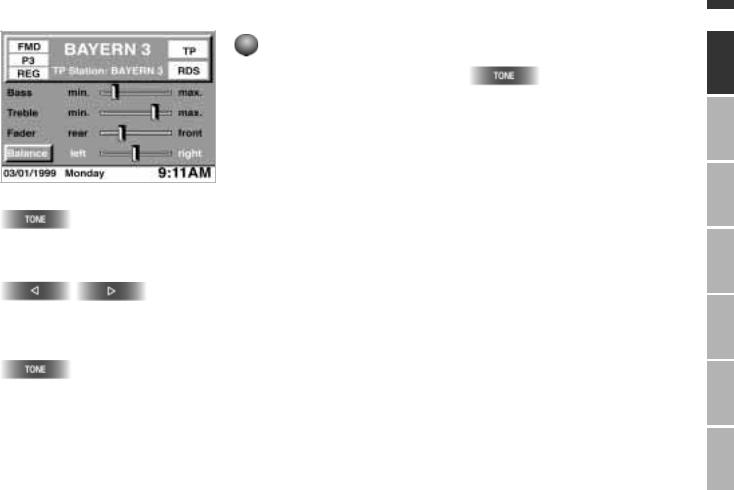
Tone control
Press this button repeatedly until the desired tone setting is highlighted (in this example, "Balance").
Press until the desired setting is reached.
Alternatively:
Press the button.
1Turn until the control symbol for the desired feature is highlighted, e.g. Balance.
2Press to select this function.
3Turn to change the setting.
4Press to store this setting.
19n
To adjust all tone settings to medium values:
Keep the button pressed in.
The display goes out eight seconds after the button has last been pressed. The modified settings are stored automatically.
Computer Radio Navigation Overview
Index Technical TV

20 Traffic reports
Switching on
Press the button.
The radio then broadcasts traffic reports even if the station you have selected does not do so.
While traffic reports are being received, TV reception and cassette or CD play are interrupted. The speech output of the navigation system, however, remains active.
Displays and signals
TP
Traffic Programme switched on.
T
TP not switched on, but the selected radio station does broadcast traffic reports.
Continuous tone
No traffic report station can be found.
Adjusting volume
Turn the left-hand knob during a traffic report until the desired volume is obtained.
This volume is retained for traffic reports even if you set other audio sources to minimum values.
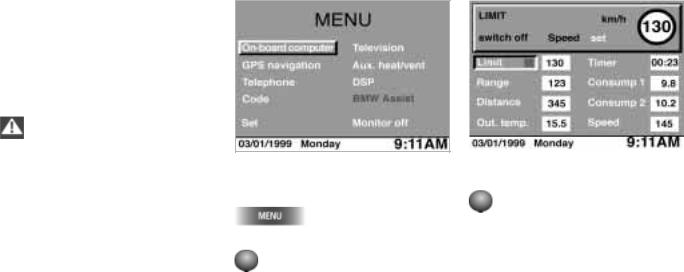
Selecting road speed at which limit signal is heard
An example for operating the on-board computer:
You decide to limit your speed to
130 km/h (approx. 80 mph) when driving on a motorway and therefore want a limit signal to be given when you have reached this road speed.
Perform all inputs while the vehicle is stationary. The car's occu-
pants and other road users could otherwise be put at risk.c
1 Selecting the on-board computer
The general menu will appear.
1 Turn until "On-board computer" is highlighted.
2 Press to select it.
|
21n |
|
|
|
|
|
|
Overview |
|
|
|
|
|
|
|
|
Navigation |
|
|
|
|
|
Radio |
2 Selecting function |
|
|
|
|
|
|
|
|
|
|
|
1 Turn until "Limit" is highlighted. |
|
Computer |
|
|
|
2 Press to enable inputs to be made. |
|
|
|
|
|
|
|
|
|
|
TV |
|
|
|
|
|
Technical |
|
|
|
|
|
Index |
|
|
|

22 Selecting road speed at which limit signal is heard
3 Entering speed limit
1Turn until "set" is highlighted.
2Press to begin making inputs.
3Turn until the desired speed 130 km/h is displayed.
4Press to store this value:
A green rectangle lights up next to the word "Limit".
Limit reached
dThe warning signal is heard.
dThe rectangle next to the word "Limit" turns red.
dThe selected limit speed is shown briefly in the instrument cluster .
The speed limit reminder is only repeated if the car has in the meantime been driven at least 5 km/h (approx. 3 mph) slower.
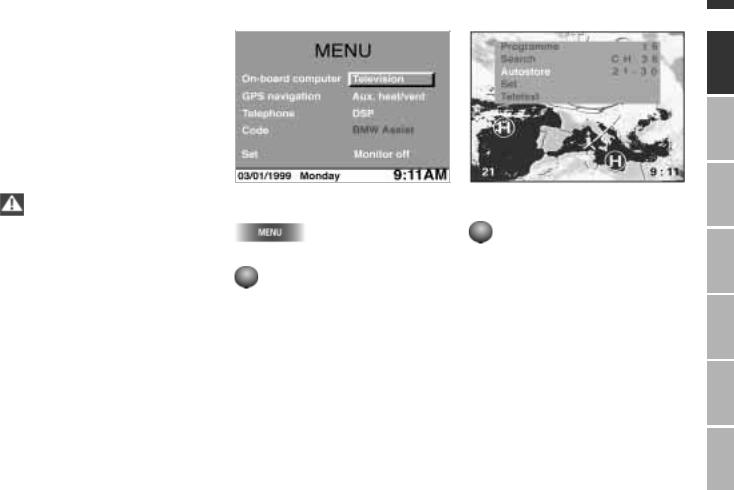
Automatically storing TV stations and viewing enjoyment |
23n |
Example of TV operation:
You wish to store the 10 TV stations with the strongest signal automatically and then call a station up on the TV screen.
For your own safety, the TV image is received only up to a speed of 3 km/h (approx. 2 mph), whereas the accompanying sound signal can be heard while the car is being driven.
Perform all inputs while the vehi- |
1 Selecting Television |
2 Stations, storing automatically |
|
cle is stationary. The car's occu- |
|||
|
|
||
pants and other road users could other- |
|
|
|
wise be put at risk.c |
|
|
The general menu appears.
1Turn until "Television" is highlighted.
2Press to select it.
1Turn or press until the TV menu is shown.
2Turn until "Autostore" is highlighted.
3Press to start an automatic station search and store routine.
If the inputs are not made within four seconds, this process will have to be repeated, as the menu disappears again.
The first 10 stations are stored in preset locations 21-30.
Computer Radio Navigation Overview
Index Technical TV

24 Automatically storing TV stations and viewing enjoyment
3 Selecting a station
The station stored on preset 21 is automatically shown.
To select a different stored station:
Turn until the desired station appears.
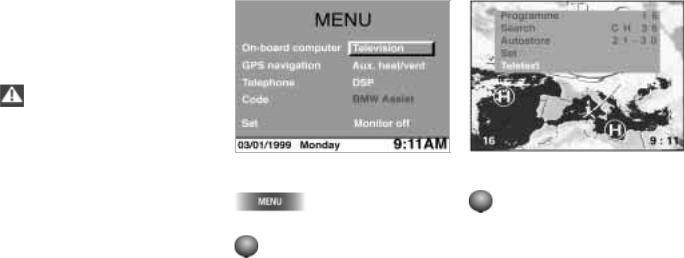
Latest information always available via teletext
Teletext can be used to display the latest news from the world of politics, business, culture, society and sport, the weather forecast and the traffic situation on the monitor.
Perform all inputs while the vehicle is stationary. The car's occu-
pants and other road users could otherwise be put at risk.c
1 Selecting Television
The general menu appears.
1 Turn until "Television" is highlighted.
2 Press to select it.
|
25n |
|
|
|
|
|
|
Overview |
|
|
|
|
|
|
|
|
Navigation |
|
|
|
2 Selecting teletext |
|
Radio |
|
|
|
|
|
|
|
|
|
1 Turn or press until the TV menu is |
|
Computer |
|
|
|
shown. |
|
|
2 Turn until "Teletext" is highlighted. |
|
|
3 Press to see the teletext bulletins. |
|
|
|
|
|
|
|
|
If the inputs are not made within four |
|
|
seconds, this process will have to be |
|
|
repeated. |
|
TV |
|
|
|
|
|
|
|
|
Technical |
|
|
|
|
|
Index |
|
|
|

26 Latest information always available via teletext
3 Selecting information |
4 To quit teletext |
1Press to enter the teletext menu.
2Turn until "Page" is highlighted.
3Press and turn until the desired page number appears at the top left.
The page will be located and displayed. Subsequent pages will be displayed automatically if the information extends over more than one page.
1Press to enter the teletext menu.
2Turn until "Television" is highlighted.
3Press to return to TV reception.
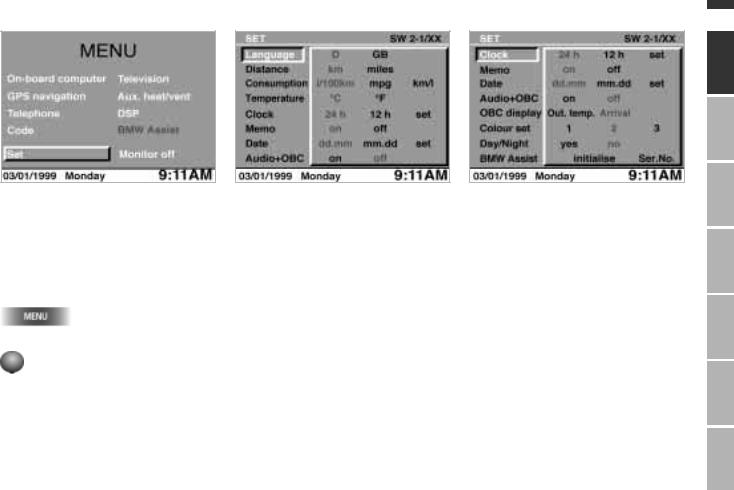
Changing the settings
27n
Navigation Overview
Your car is supplied with a basic setting for all displays, which depends on the country for which the car is intended. These settings can also be changed as preferred individually.
Changing the settings
The general menu will appear.
1Turn until "Set" is highlighted.
2Press to obtain a display of possible settings.
You can change the language of the display texts, the units of measurement for distance, fuel consumption and temperature, the time and date, and the way these are expressed.
SW 2-1/XX means: generation 2 software status, version 1.
"XX" indicates the current version.
The following can also be changed by turning the control further:
Memo: shortly before the hour, three signal tones will be emitted.
Audio+OBC means: radio and on-board computer displays appear on the monitor at the same time.
On-board computer display: you can choose whether to have the outside temperature or your estimated time of arrival shown in the general menu.
Colour set means: you select a set of colours for the screen display from the three options available.
Day/Night means: you can switch the automatic day/night changeover function for colour set on or off.
BMW Assist*: you can initialize or update the emergency call function information service if these have been arranged for you by BMW Service or BMW Customer Information.
Computer Radio
Index Technical TV
